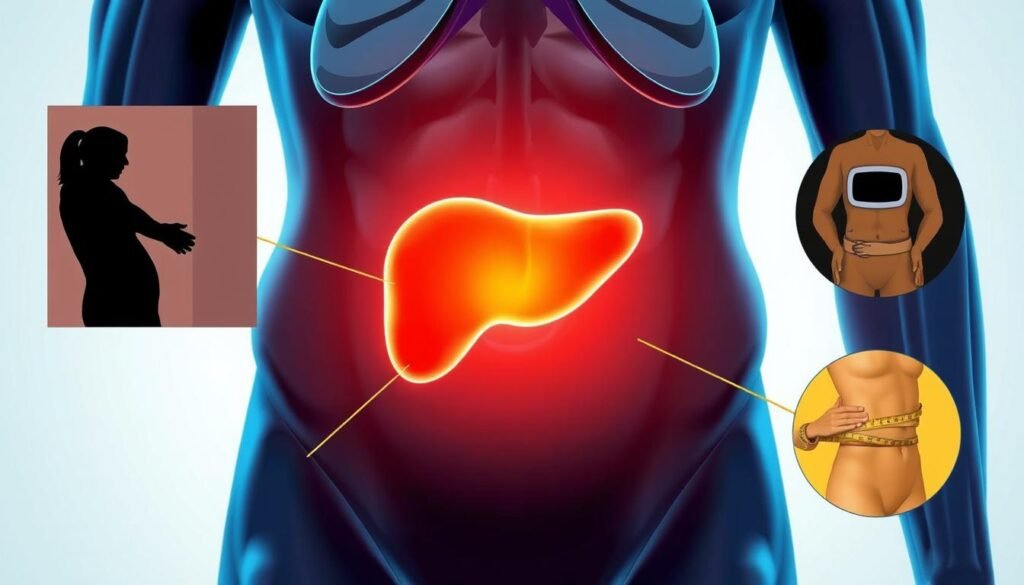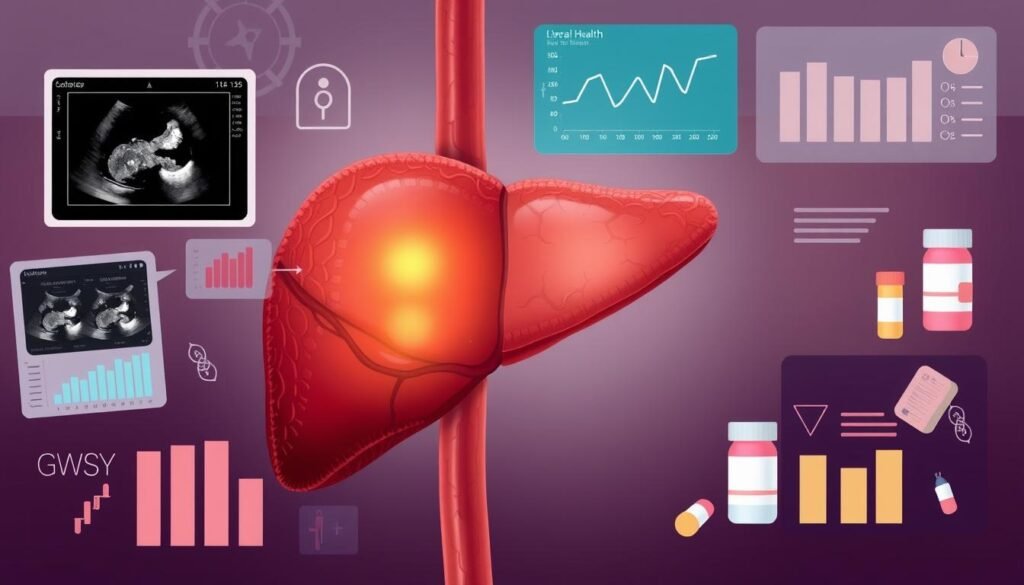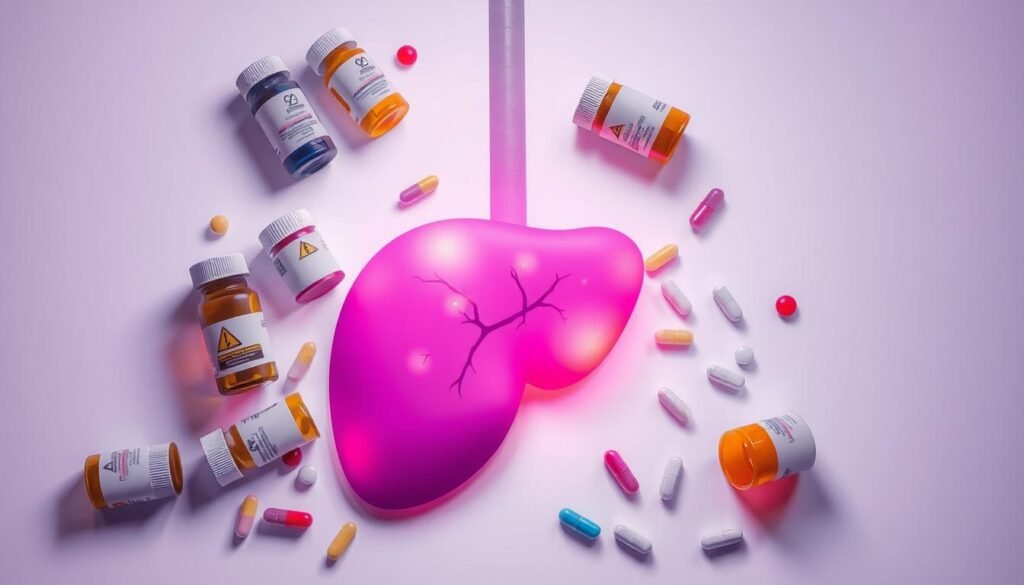Have you ever thought about how your meds might affect your liver? This guide looks into how prescription meds and fatty liver disease are connected. It talks about Non-Alcoholic Fatty Liver Disease (NAFLD) mostly. Knowing how treatments work with liver health is key. This is true for those dealing with liver disease issues. Many FDA-approved drugs are okay for people with liver conditions. But, we must be careful about the effects.
When looking at how meds affect the liver, it’s key to understand something. Liver damage doesn’t always show up right away. Blood tests can spot liver problems early on, even if there are no clear symptoms. This makes them very important for checking your liver’s health. This piece will help you learn about common meds, their impacts, and how to use them safely.
Key Takeaways
- Many FDA-approved medications are safe for patients with liver disease.
- Symptoms of liver damage may not appear until significant harm has occurred.
- Blood tests play a critical role in early detection of liver issues.
- Acetaminophen should be used cautiously, especially by individuals with liver disease.
- Statins are generally safe with minimal risk of liver damage.
- Lifestyle factors and weight loss are crucial in managing NAFLD.
- Regular monitoring and safe medication management are essential for liver health.
Understanding Fatty Liver Disease
Fatty liver disease is a big health problem that happens when fat builds up in the liver. It mostly looks at Non-Alcoholic Fatty Liver Disease (NAFLD). This includes simple fat buildup and worse issues like Non-Alcoholic Steatohepatitis (NASH). Knowing the differences helps treat liver disease better.
Definition and Types of Fatty Liver Disease
NAFLD happens when fat accumulates in the liver without much inflammation. Sometimes, it can turn into NASH, which causes inflammation and liver cell damage. This can lead to fibrosis and cirrhosis. A simple fatty liver usually doesn’t harm the liver. In the U.S., 1 in 3 adults has metabolic dysfunction-associated steatotic liver disease (MASLD), making it the most common fatty liver disease.
Prevalence and Risk Factors
About 100 million people in the U.S. have NAFLD, and it’s getting more common. It often affects people with obesity, diabetes, and high cholesterol. These are big risk factors for NAFLD. Metabolic syndrome, which includes conditions like high triglycerides and insulin resistance, raises the risk of this liver disease.
Even kids are at risk; about 10% have MASLD. It’s more common in Hispanic and Asian American kids. Unhealthy diets and not moving much increase the risk of fatty liver disease. This shows why it’s important to teach healthy habits early.
To learn more about how drugs can hurt the liver and its link to fatty liver disease, check out this interesting article.
Symptoms of Fatty Liver Disease
Fatty liver disease might not always show clear symptoms. This can make it hard to spot early on. If you notice signs that may point to a problem with Liver Health, it’s crucial to act. Catching these symptoms early helps with effective treatment.
Common Symptoms and Indicators
Some people don’t know they have fatty liver disease until it gets worse. Watch for these symptoms of liver disease:
- Persistent fatigue
- Discomfort or pain in the right upper abdomen
- Unexplained weight loss
- Nausea or loss of appetite
- Jaundice, which makes the skin and eyes yellow
Ignoring the signs can lead to worse liver health. Know these indicators to catch risks early.
When to Seek Medical Attention
If you feel very tired all the time, have belly discomfort, or see signs of jaundice, you should seek medical attention right away. Finding the problem early can stop serious issues like cirrhosis or liver failure. Staying ahead of fatty liver disease is key to keeping your liver healthy.

Diagnosis of Non-Alcoholic Fatty Liver Disease (NAFLD)
To figure out if someone has non-alcoholic fatty liver disease (NAFLD), doctors use several steps. First, they do blood tests to check liver function. They look at enzyme levels, such as AST and ALT, in these tests. Then, they might do more blood tests to see lipid levels, blood sugar, and check for hepatitis.
High levels of liver enzymes might suggest NAFLD.
Blood Tests and Liver Function Tests
Liver function tests are key to looking at liver health. They check enzyme levels and spot any issues. Doctors also look at triglycerides, cholesterol, and glucose in the blood. These can be linked to fatty liver disease. Knowing what these tests say helps doctors figure out what to do next.
Imaging Techniques for Diagnosis
For NAFLD, imaging helps a lot. Tools like ultrasound, CT scans, and MRI can show fat in the liver. They give a clear picture of the liver’s health. This way, doctors can tell NAFLD apart from other liver problems. Good imaging makes it easier to confirm if someone has NAFLD.
Liver Biopsy: When is it Necessary?
Sometimes, doctors need more info and do a liver biopsy. This is when they aren’t sure how bad the liver damage is after other tests. They take a small piece of liver tissue to look at closely. This helps them see if there is inflammation or fibrosis. It also can show if the NAFLD has turned into NASH. Knowing when to do a biopsy helps with treating NAFLD right.

Prescription Medications and Fatty Liver
It’s important to know how prescription meds affect liver health, especially for those with fatty liver disease. The liver’s function may be weakened, making some drugs risky due to their potential to harm the liver.
Common Medications Impacting Liver Health
There are many meds that can be bad for your liver. These include:
- Acetaminophen (Tylenol)
- Statins
- Some anti-seizure medications
- Antibiotics
- Corticosteroids
Those on these drugs should watch for Medication Side Effects. Talking often with your doctor is key when you have liver issues.
Understanding Hepatotoxicity and Side Effects
Hepatotoxicity means liver damage from drugs, which can happen without clear symptoms. If you’re using meds like Rezdiffra, look out for signs such as:
- Jaundice
- Nausea
- Lack of appetite
If you notice these symptoms, tell your doctor right away. They can help prevent more liver harm. Adjusting or stopping your medication might be needed.
Safe Medication Management for Liver Health
Good Safe Medication Management can make a big difference for people with liver problems. Some smart steps are:
- Keeping an up-to-date list of your meds.
- Talking to healthcare pros about how meds might affect your liver.
- Avoiding meds with similar ingredients can help reduce liver injury risks.
By managing medications wisely, you can help keep your Liver Health in check while taking care of other health issues.

Current Treatments for NAFLD
Managing non-alcoholic fatty liver disease (NAFLD) involves multiple strategies. This includes Lifestyle Modifications and Medications. Patients must make big changes to improve their Healthy Liver and lessen the disease’s impact.
Lifestyle Modifications: Diet and Exercise
Treating NAFLD starts with changing your lifestyle. Eating right and staying active are key. They help manage liver fat and boost overall health. Losing weight can make your liver work better, leading to good health outcomes. Experts suggest:
- Doing moderate exercise for at least 150 minutes each week.
- Watching how many calories you eat to help with weight control.
- Eating lots of fruits, veggies, and whole grains.
These Lifestyle Modifications fight NAFLD and stop it from getting worse. For more info on liver health and liver-based skin problems, click here.
Role of Medications in NAFLD Treatment
Medicines can help if you find it hard to lose weight or stick to a diet. The main treatments for NAFLD include:
- Pioglitazone: This medicine helps improve liver in NASH patients. It works over 6 to 24 months.
- Vitamin E: It’s good for people with NASH who don’t have diabetes. It lowers liver enzymes and fat.
- Metformin: Helps with fat and inflammation in the liver but doesn’t change the liver structure much.
It’s important to watch for side effects from these drugs. Both pioglitazone and vitamin E can cause problems if not used right. Researchers are still looking for the best way to treat NAFLD for better health results.
Role of Insulin Sensitizers and Vitamin E
Tackling non-alcoholic fatty liver disease (NAFLD) means looking at different treatments. Insulin Sensitizers like Thiazolidinediones play a big role. They make the body more sensitive to insulin and help reduce liver fat. Vitamin E also shows promise because of its antioxidant effects. We’ll now look into how well these treatments work for NAFLD.
Effectiveness of Thiazolidinediones
Thiazolidinediones, pioglitazone for example, are used to boost insulin sensitivity in those with type 2 diabetes. These drugs can lower liver fat and reduce inflammation from NAFLD. Despite the benefits, there are risks such as weight gain and heart failure. Still, they significantly help by improving liver function and its physical condition.
Impacts of Antioxidants in Treatment
Vitamin E is known for being a strong antioxidant. It reduces oxidative stress in the liver. This vitamin can lessen liver inflammation and better enzyme levels in NASH patients. The positives are clear, but high doses for a long time can be risky. Always talk to a healthcare provider before starting vitamin E to stay safe.
| Medication | Type | Primary Benefit | Potential Side Effects |
|---|---|---|---|
| Pioglitazone | Thiazolidinedione | Improves insulin sensitivity, reduces liver fat | Weight gain, heart failure risk |
| Vitamin E | Antioxidant | Reduces liver inflammation, improves liver enzymes | Potential risks with high-dose long-term use |
Dietary Supplements and Herbal Remedies
Many people seek out dietary supplements and herbal remedies to improve liver health. It’s important to weigh the benefits against the risks. The market for these products has grown, moving from $9.6 billion in 1994 to $36.7 billion in 2014. Now, between one-third and one-half of adults in the U.S. use a dietary supplement.
Potential Benefits and Risks
Herbal remedies might offer health boosts. But they’re not as closely regulated as medicines. Studies show that 20% of liver damage from toxins in the U.S. is linked to herbal supplements. Products like turmeric, green tea extract, and ashwagandha are targeted at liver health. Yet, over half of these supplements could be wrongly labeled.
Common Supplements to Avoid
Some supplements have a bad reputation for causing liver damage and should be avoided. This includes items like kava, comfrey, and certain bodybuilding supplements. More than 45 instances of liver harm in the U.S. are tied to bodybuilding products. Always ask a health professional before starting any herbal treatments, especially if you’ve had liver issues.
For detailed information on herbal remedies and liver health, resources like LiverTox are very helpful. They offer insights and warnings on what to use and what to avoid.
Monitoring Liver Health During Treatment
It’s vital to watch your liver health when dealing with NAFLD. Regular check-ups help avoid problems and ensure the best results. A big part of this is getting Liver Function Tests. These tests tell us how well your liver works and if we need to change your treatment.
Importance of Regular Liver Function Tests
Liver Function Tests are key for catching issues early. They check your blood for specific markers that show how your liver is doing. By watching these levels, doctors can spot changes early on. If certain enzymes like ALT and AST go up, it could mean your liver is in trouble. This needs a quick check-up to avoid serious issues.
Adjusting Medication Based on Liver Health
Changing medication based on your liver’s health is crucial. Your liver affects how drugs are processed, so dosages need to match your liver’s condition. If the liver isn’t working well, drugs might not break down properly. This can increase the risk of harmful effects. That’s why talking with your doctor about any new symptoms is essential. It helps adjust your medicine to keep your liver healthy.
Conclusion
Managing fatty liver disease takes a mix of lifestyle changes and careful medication use. Almost 40% of adults in the U.S. suffer from MASLD, so talking to doctors about treatment is crucial. Effective treatments include medicines like resmetirom and semaglutide, which help reduce liver fat.
To avoid drug-induced liver issues, patients should keep an eye on their medicine use. Working closely with healthcare providers helps create effective treatment plans. This approach looks after the liver for the long term. It’s important to adjust treatments and consider medicines that improve liver health over time.
With MAFLD becoming more common, personalized and careful treatment is essential. Highlighting diet, exercise, and the right medications helps patients manage their liver health better. This strategy aims for a healthier future.